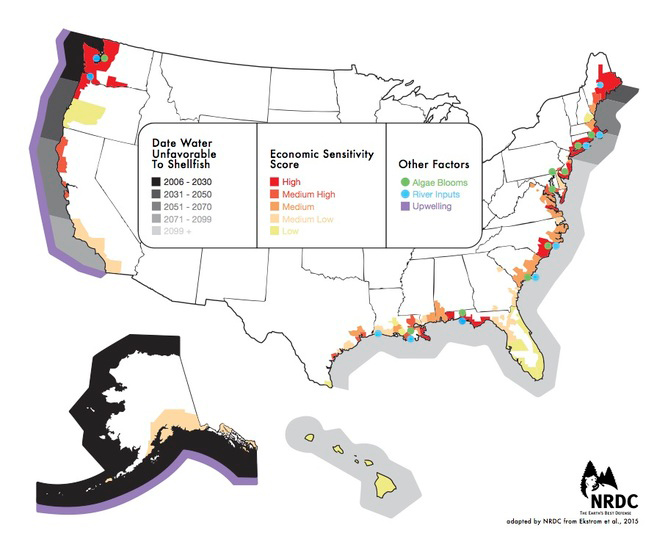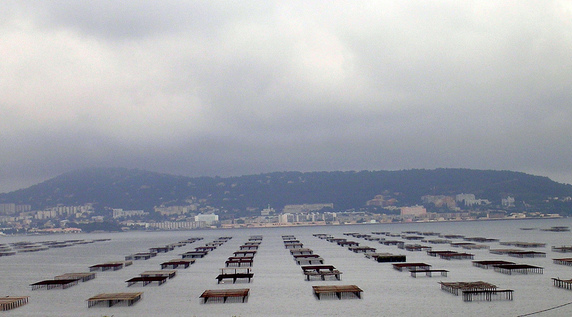April 8, 2015 — Oceans are gradually becoming warmer and more acidic as more carbon dioxide enters the atmosphere — two shifts that are altering the economic foundations of many coastal regions.
In a new study published in Nature Climate Change, we and our colleagues set out to identify hot spots around the United States for ocean acidification.
We found the impact is most likely to be substantial in coastal communities that depend heavily on shellfish harvests and where resources and knowledge to guard against harvest losses are low.
Communities facing environmental changes often don’t know where or how to start adapting for the future. Typically, when it comes to ocean changes that affect marine harvests, coastal communities have a hard time planning for the next decade. This year and the next are difficult enough, with ever-changing markets, rules on how much seafood can harvested, and natural variability in the fish and shellfish stocks themselves. Ocean acidification and warming, which are playing out over long time frames, makes it even more difficult to plan.
Yet coastal communities need to start preparing. Ocean acidification robs bivalves of their ability to quickly grow protective shells and causes other problems for shellfish.
The oyster industry in the Pacific Northwest, for example, has been hard-hit in the past 10 years by ocean acidification. Natural upwelling of waters soured by ocean acidification drove multiple years of larval oyster die-offs in hatcheries there, jeopardizing a $272 million industry that supports more than 3,200 jobs.
Nuanced Picture
Our study synthesized data from ocean models, river and estuary databases, shellfishery harvest records, and social information, such as the diversity of job opportunities and the proximity of marine research centers.
Compiling this data in geospatial mapping software allowed us to make regional comparisons between areas that hadn’t previously been evaluated using the same types of measurements.

Upwelling, river discharge, and nutrient pollution worsen ocean acidification. Meanwhile, ocean acidification continues to grow due to atmospheric carbon dioxide levels, and it will reach a critically harmful point for shellfish larvae at different dates around the country (gray tones). On land, dependence on shellfish harvests and communities’ ability to cope can be combined into economic vulnerability score (red tones). NRDC (author provided).
The good news is that no single community has the triple threat of substantial ocean acidification, heavy dependence on shellfish harvests, and little knowledge and community resources. But the bad news is that many communities have two out of three of these factors, making ocean acidification a nationwide problem.
For example:
- The Pacific Northwest: rapid ocean acidification, heavy shellfish dependence
- New England: heavy shellfish dependence, limited knowledge/resources
- Louisiana: valuable oyster industry in key parishes, limited knowledge/resources
- Northern California: rapid ocean acidification, large shellfish harvests
- Virginia, Maryland: moderate ocean acidification risk, growing shellfish industries, limited resources
This study shows us that vulnerability to ocean acidification is a more nuanced issue than we’ve previously thought.
Not only does it depend on oceanographic factors, but it also depends on social factors, including how connected local industry is to environmental monitoring and research efforts. These factors affect how nimble a shellfish-dependent community will be in developing adaptations against ocean acidification, whether it has already appeared — as in the Pacific Northwest — or it is yet to arrive, as is the case in most other areas of the nation.
Regional Actions
Finding ways to future-proof coastal communities against ocean acidification is beginning, as individual states, including Washington, Maine and Maryland, convene panels to assess the local implications of ocean acidification and consider what needs to be done.
It’s clear from our study and from the conclusions of emerging state panels that preparing for ocean acidification’s impacts will involve regionally specific actions.

Aquaculture will need to adapt in different ways because of ocean acidification. Photo by Astacus (Flickr/Creative Commons).
Some areas need to work on fixing the things that worsen ocean acidification, like fertilizer pollution. Other areas need to build stronger networks for sharing knowledge and ideas for sidestepping the worst of ocean acidification’s impacts.
Communities with strong links among researchers, industry and resource managers, like those in Oregon and Washington state, have very nimbly built partnerships for monitoring and improving water quality in hatchery tanks. These adaptations have already prepared this industry to offset immediate losses from acidification. Still other areas may need to think of ways to diversify harvests or culture larvae (usually the most sensitive life stage) in protected environments.
More investment in ocean acidification research will not only shed more light on the “when, where and how bad” questions that are on everyone’s minds, but it will also support the development of needed social information-sharing networks that are critically needed to prepare communities for ocean acidification. It’s the right time to make these investments, because planning for the future always works better before a crisis begins. ![]()
![]()
This article was originally published on The Conversation. Read the original article.
Editor’s note: The views expressed here are those of the author and not necessarily of Ensia. We present them to further discussion around important topics. We encourage you to respond with a comment below, following our commenting guidelines, which can be found here. In addition, you might consider submitting a Voices piece of your own. See Ensia’s “Contact” page for submission guidelines.
Ensia shares solutions-focused stories free of charge through our online magazine and partner media. That means audiences around the world have ready access to stories that can — and do — help them shape a better future. If you value our work, please show your support today.
Yes, I'll support Ensia!


Thus, the PNW commercial shellfish problems in the last decade seem to have been natural events, not man-made. What's really needed is a better understanding of water properties and flows at different depths from inshore growing areas out to the edge of the continental shelf. Rather than talking about possible future acidification problems, we instead need to talk about securing funding for the oceanographic research that will clarify today's problems.
http://landscapesandcycles.net/ocean-acidification-natural-cycles---uncertainties.html